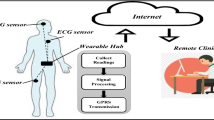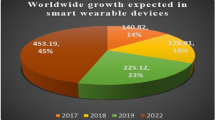Abstract
Electrocardiogram, electromyogram, electroencephalogram are the foremost required vital signs for diagnosing chronic diseases like sleep disorder, mood disorder, epilepsy etc., which demands long-term monitoring. A sensor based wearable system which is enabled with internet technology, supports the continuous recordings of these vital signs without troubling the patient’s daily activities. And the wearable hub is responsible for collecting the readings of biosignals from multiple micro-sensor nodes deployed around the body which creates the short range of communication and forward to the observer. These continuous monitoring increases the signal transmission cost and declines the battery life of wearables. So, the observed multiple biosignals can be compressed jointly than individually before sending, at an edge level. This paper proposes transfer learning based multimodal convolutional denoising auto encoder to perform multimodal compression and to reconstruct the data from its latent representation. Transfer learning helps the system to reuse the learned weights which may reconstruct the data with better quality score than by randomly initialized weights. The proposed work achieves compression ratio of 128 and it is proved that multimodal compression is better than unimodal compression in case of consuming multiple sensors. And the experimental result proves that the computation cost is low in multimodal compression than in unimodal compression.








Similar content being viewed by others
References
Ahmed B, Amr M, Khaled H, Jane W (2017) Multimodal deep learning approach for joint EEG-EMG data compression and classification. IEEE Wirel Commun Netw Conf (WCNC). https://doi.org/10.1109/WCNC.2017.7925709
Akila T, Kumaragurubaran G (2021) An improved feature selection based classifier for prediction of different regions in Sar images. Multimed Tools Appl 80:33641–33662
Ali A, Mohammad A, Erik S, Kevin E (2020) A deep transfer learning approach to reducing the effect of electrode shift in EMG pattern recognition-based control. IEEE Trans Neural Syst Rehab Eng 28:370–379. https://doi.org/10.1109/TNSRE.2019.2962189
Amit S, Samaresh B, Sudip M (2015) Link quality-aware resource allocation with load balance in wireless body area networks 74–81. https://doi.org/10.1109/JSYST.2015.2458586
Andrzejak RG, Lehnertz K, Mormann F, Rieke C (2001) Indications of nonlinear deterministic and finite-dimensional structures in time series of brain electrical activity: dependence on recording region and brain state. Phys Rev E Stat Nonlin Soft Matter Phys 64:061907. https://doi.org/10.1103/physreve.64.061907
Anna MR, Dixon G, Allstot G (2012) Compressed sensing system considerations for ECG and EMG wireless biosensors. IEEE Trans Biomed Circ Syst 6:156–166. https://doi.org/10.1109/TBCAS.2012.2193668
Bing X, Zhemin D, Bin Z (2019) Research on target object recognition based on transfer-learning convolutional SAE in intelligent urban construction. IEEE Access 7:125357–125368. https://doi.org/10.1109/ACCESS.2019.2939284
Bowen D, Ronggui W, Juan Y, Lixia X (2021) Multi-scale feature self-enhancement network for few-shot learning. Multimed Tools Appl 80:33865–33883 57 access
Carotti ESG, Juan C (2019) Compression of multidimensional biomedical signals with spatial and temporal codebook-excited linear prediction. IEEE Trans Biomed Eng 56:2604–2610. https://doi.org/10.1109/TBME.2009.2027691
Chao S, Wen M, Zhang K, Ping M (2021) Traffic sign detection algorithm based on feature expression enhancement. Multimed Tools Appl 80:33593–33614
Chuang S, Meng M (2018) Deep transfer learning based on sparse autoencoder for remaining useful life prediction of tool in manufacturing. IEEE Trans Ind Inf 15:2416–2425. https://doi.org/10.1109/TII.2018.2881543
Craven D, Brian M, Liam K (2014) Compressed sensing for bioelectric signals: a review. IEEE J Biomed Health Inf 529–540. https://doi.org/10.1109/JBHI.2014.2327194
Del Testa D, Michele R (2015) Lightweight lossy compression of biometric patterns via denoising autoencoders. IEEE Signal Proc Lett 22:2304–2308. https://doi.org/10.1109/LSP.2015.2476667
Evaldas V, Matej U (2018) Learning low-dimensional representation of bivariate histogram data. IEEE Trans Intell Transp Syst 19:3723–3735. https://doi.org/10.1109/TITS.2018.2865103
Goldberger A (2000) Physiobank, PhysioToolkit, and PhysioNet:Components of a new research resource for complex physiological signals. Circulation 101:1–6. https://doi.org/10.1161/01.cir.101.23.e215
Hannah R, Kiri L, Wagstaff D, Patrick G, James F (2019) Toward generalized change detection on planetary surfaces with convolutional auto encoders and transfer learning. IEEE J Sel Top Appl Earth Observ Remote Sens 12:3900–3918. https://doi.org/10.1109/JSTARS.2019.2936771
Hsin-Tien C, Hsieh Y (2020) Noise reduction in ECG signals using fully convolutional denoisingautoencoders. IEEE Access 7:60806–60813. https://doi.org/10.1109/ACCESS.2019.2912036
Junlin H, Jiwen L (2016) Deep transfer metric learning. IEEE Trans Image Process 25:5576–5588. https://doi.org/10.1109/TIP.2016.2612827
Klosch G, Kemp B, Penzel A, Schlogl P (2001) The SIESTA project poly graphic and clinical database. IEEE Eng Med Biol 20:51–57. https://doi.org/10.1109/51.932725
Lang J, Ying Z, Xiao L, Wen J, Yong-Hong L, Zhao J (2017) Postictal apnea as an important mechanism for SUDEP: a near-SUDEP with continuous EEG-ECG-EMG recording. Elsevier J Clin Neurosci 43:1–3. https://doi.org/10.1016/j.jocn.2017.04.035
Liu S, Mengjing Y, Li M, Qingzhen X (2019) The research of virtual face based on deep convolutional generative adversarial networks using tensor flow. Phys A Stat Mech Appl 521(9):667–680
Marco T, Simone B (2015) Power line interference removal for high quality continuous bio-signal monitoring with low-power wearable devices. IEEE Sensors J 16:3887–3895. https://doi.org/10.1109/JSEN.2016.2536363
Mohsen H, Davide Z (2019) Boosting the battery life of wearables for health monitoring through the compressionof biosignals. IEEE Internet Things J 4:1647–1662. https://doi.org/10.1109/JIOT.2017.2689164
Moody GB, Mark RG, Goldberger AL (2001) Physionet: a web-based resource for the study of physiologic signals. IEEE Eng Med Biol Mag 20:70–75. https://doi.org/10.1109/51.932728
Neha S, Reecha S, Neeru J (2021) Prediction of face age progression with generative adversarial networks. Multimed Tools Appl 80:33911–33935
Qingzhen X (2013) A novel machine learning strategy based on two-dimensional numerical models in financial engineering. Math Probl Eng. https://doi.org/10.1155/2013/659809
Qingzhen X, Gvuangyi H, Mengjing Y, Yanliang G (2019) A novel edge-oriented framework for saliency detection enhancement, image and vision. Computing 87(1):1–12
Qingzhen X, Gvuangyi H, Mengjing Y, Yanliang G (2020) Fall prediction based on key points of human bones. Phys A Stat Mech Appl 532(5):123205
Qingzhen X, Jiayong W, Qiang C (2014) A novel mobile personalized recommended method based on money flow model for stock exchange. Math Probl Eng. https://doi.org/10.1155/2014/353910
Qingzhen X, Wang Z, Wang F, Yongyi G (2019) Multi-feature fusion CNNs for Drosophila embryo of interest detection. Phys A: Stat Mech Appl 531(19):121808
Senlin Y, Xin C (2021) Study on feature extraction technology of real-time video acquisition based on deep CNN. Multimed Tools Appl 80:33937–33950
Shaohua H, Yu G, Daoyuan L, Shanshan Z, Weiguang F (2019) A two-stage transfer learning-based deep learning approach for production Progress prediction in IoT-enabled manufacturing. IEEE Internet Things J 6:10627–10638. https://doi.org/10.1109/JIOT.2019.2940131
Singh A, Samarendra D (2017) Block sparsity-based joint compressed sensing recovery of multi-channel ECG signals. Healthc Technol Lett 4:50–56. https://doi.org/10.1049/htl.2016.0049
Sourav Kumar Mukhopadhyay M (2018) SVD and ASCII character encoding-based compression of multiple biosignals for remote healthcare systems. IEEE Trans Biomed Circ Syst 12:137–150. https://doi.org/10.1109/TBCAS.2017.2760298
Stanislas C, Galtier MN, Arnal PJ, Gilles W, Alexandre G (2018) A deep learning architecture for temporal sleep stage classification using multivariate and multimodal time series. IEEE Trans Neural Syst Rehab Eng 26:758–769. https://doi.org/10.1109/TNSRE.2018.2813138
Wang F, Qiming M, Wenhan L (2020) A novel ECG signal compression method using spindle convolutional auto-encoder. ELSEVIER Comput Methods Programs Biomed 175:139–150. https://doi.org/10.1016/j.cmpb.2019.03.019
Xu X, Ning Z, Houbing S, Anfeng L, Ming Z (2018) Adaptive beaconing based MAC protocol for sensor based wearable system, 29700-29714. https://doi.org/10.1109/ACCESS.2018.2843762
Youshen C, Hanzhi Z (2020) Hybrid deep learning model assisted data compression and classification for efficient data delivery in mobile health applications. IEEE Access 8:94757–94766. https://doi.org/10.1109/ACCESS.2020.2995442
Author information
Authors and Affiliations
Corresponding author
Ethics declarations
Conflict of Interest and Authorship Conformation Form.
Please check the following as appropriate:
All authors have participated in (a) conception and design, or analysis and interpretation of the data; (b) drafting the article or revising it critically for important intellectual content; and (c) approval of the final version.
This manuscript has not been submitted to, nor is under review at, another journal or other publishing venue.
The authors have no affiliation with any organization with a direct or indirect financial interest in the subject matter discussed in the manuscript.
The following authors have affiliations with organizations with direct or indirect financial interest in the subject matter discussed in the manuscript:
Additional information
Publisher’s note
Springer Nature remains neutral with regard to jurisdictional claims in published maps and institutional affiliations.
Rights and permissions
About this article
Cite this article
Panneerselvam, I.R. Transfer learning autoencoder used for compressing multimodal biosignal. Multimed Tools Appl 81, 17547–17565 (2022). https://doi.org/10.1007/s11042-022-12597-6
Received:
Revised:
Accepted:
Published:
Issue Date:
DOI: https://doi.org/10.1007/s11042-022-12597-6




